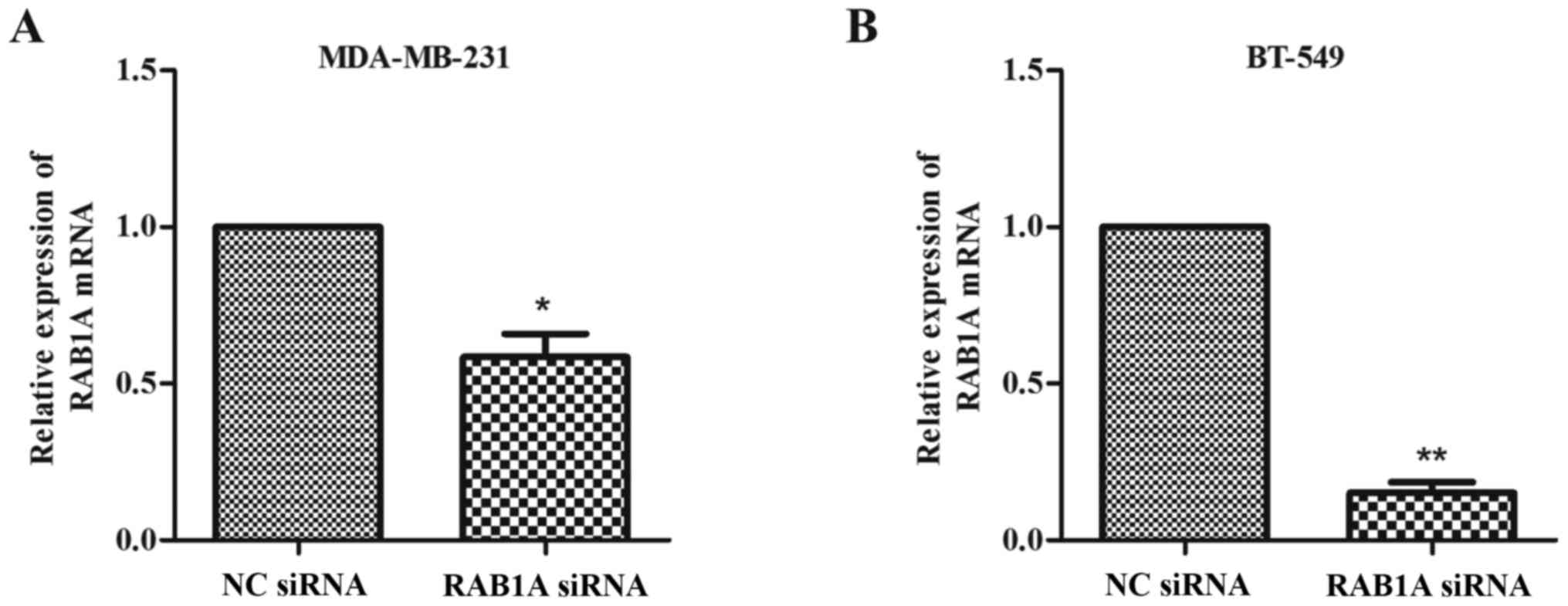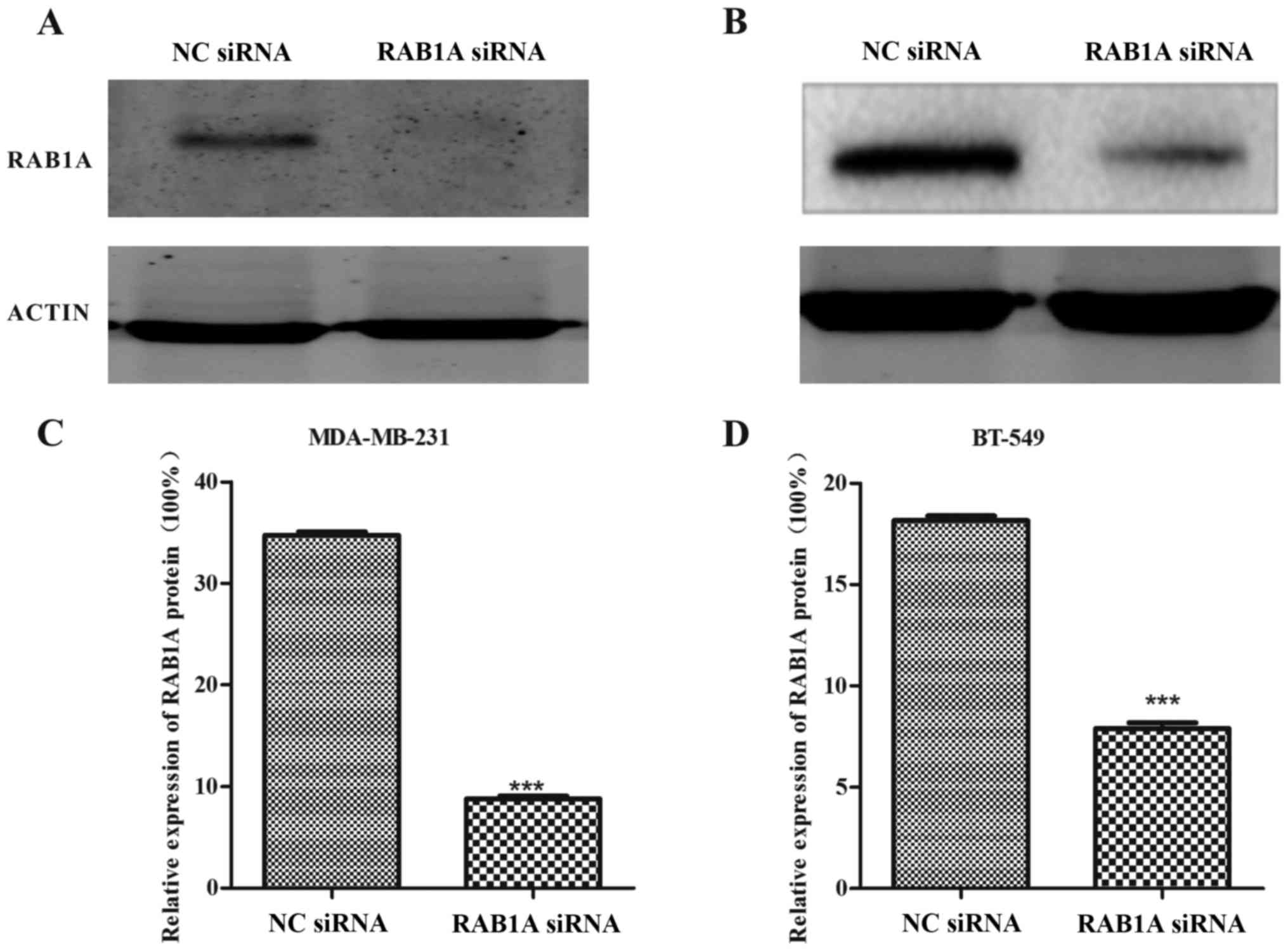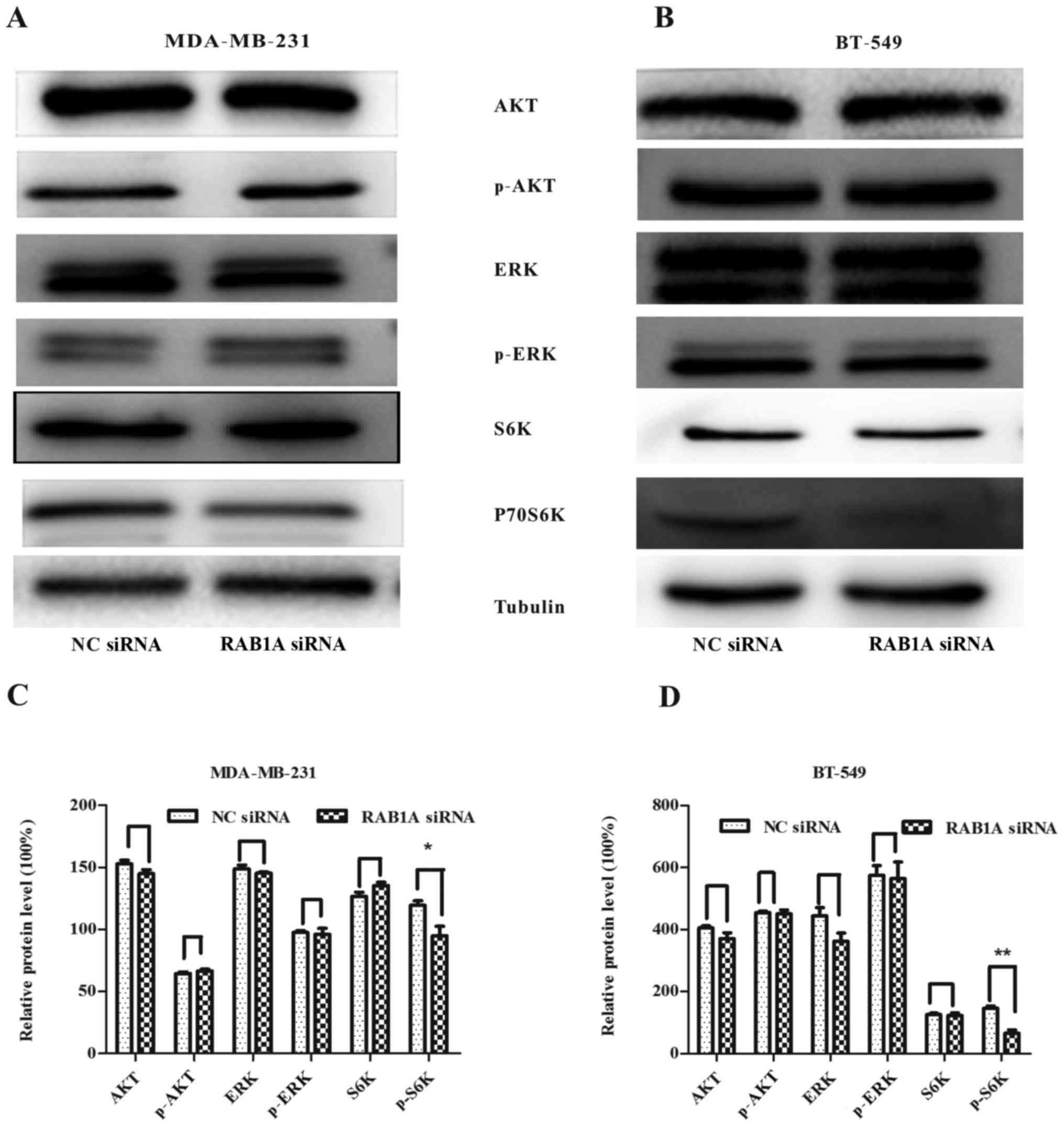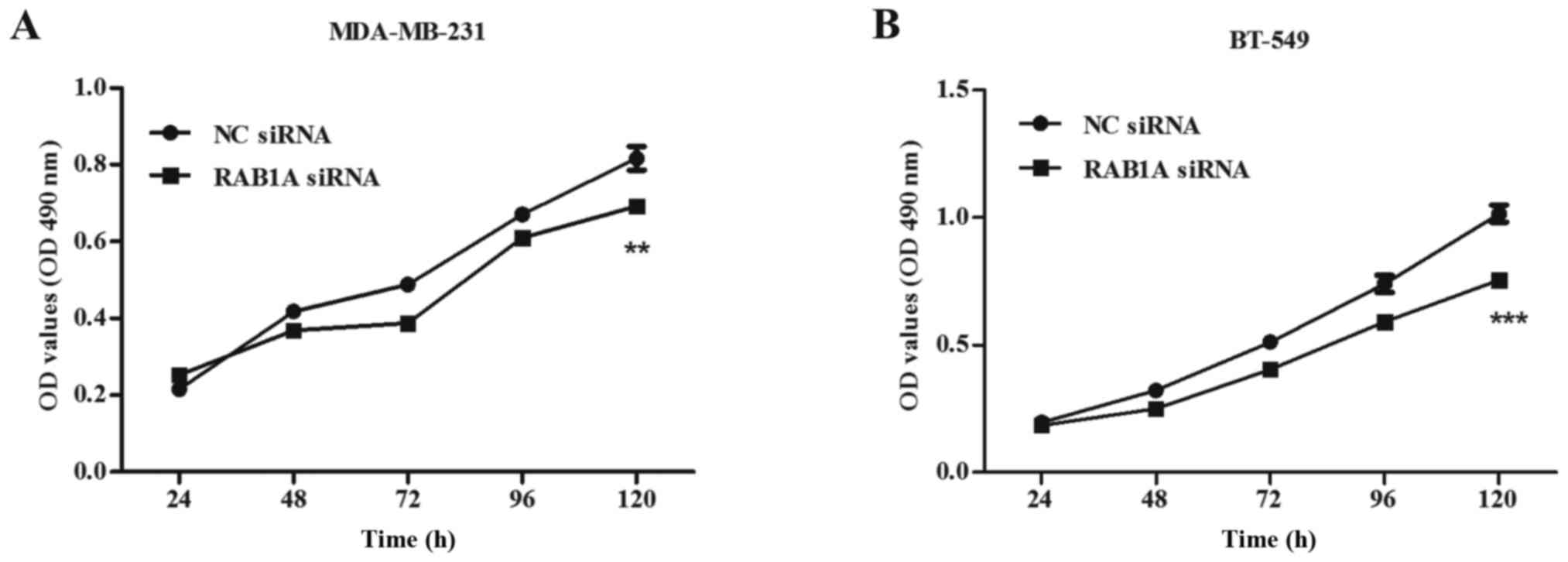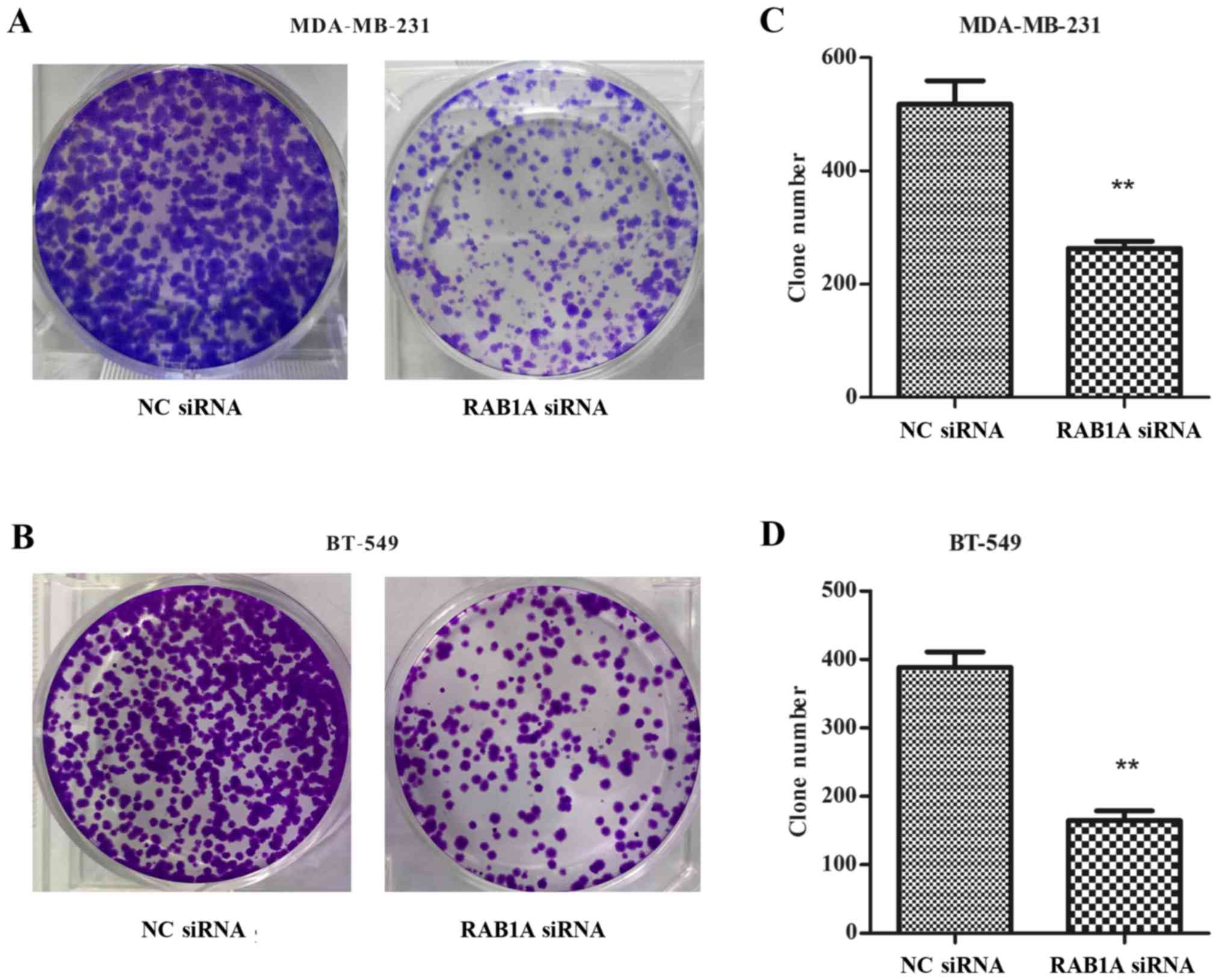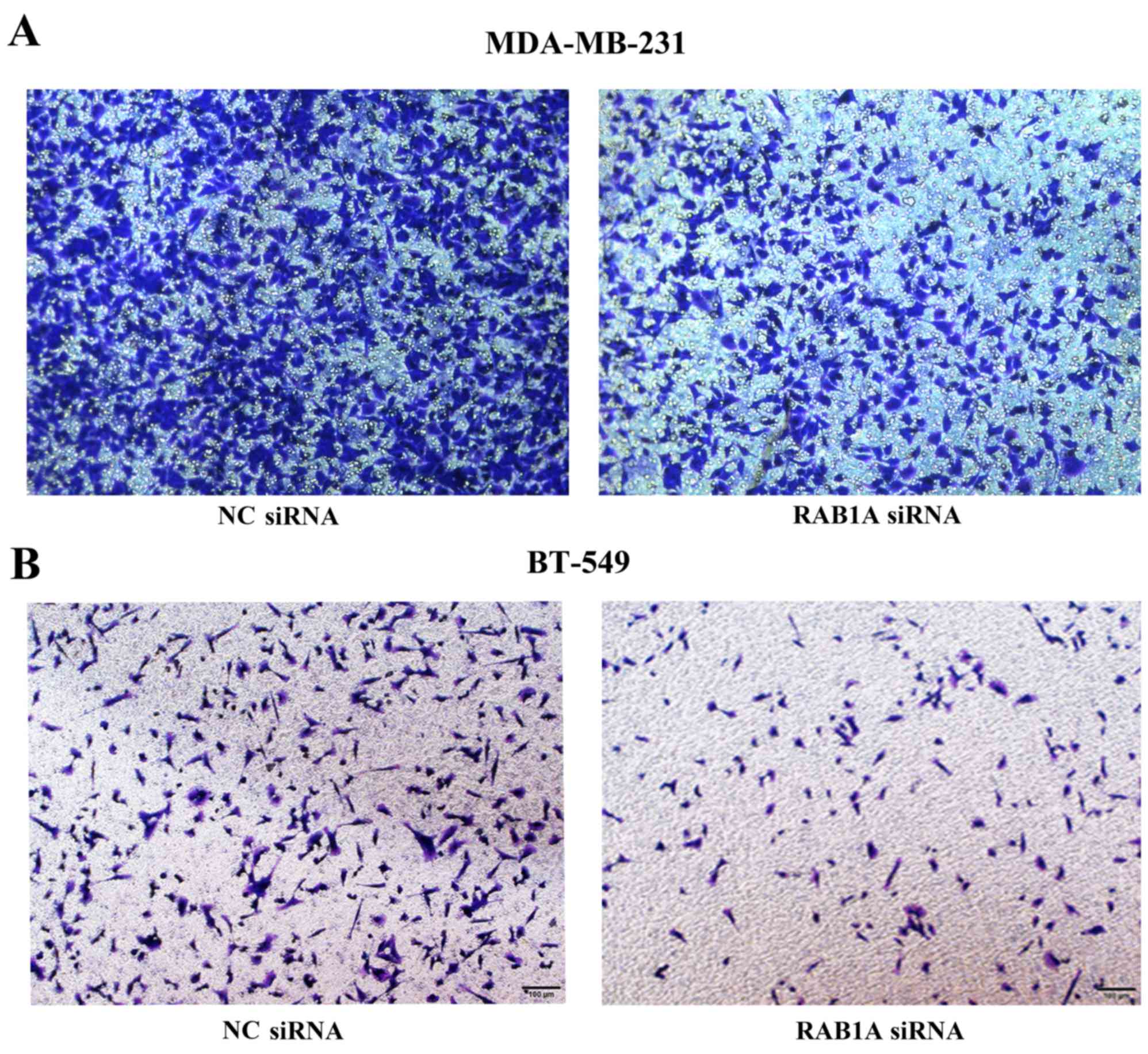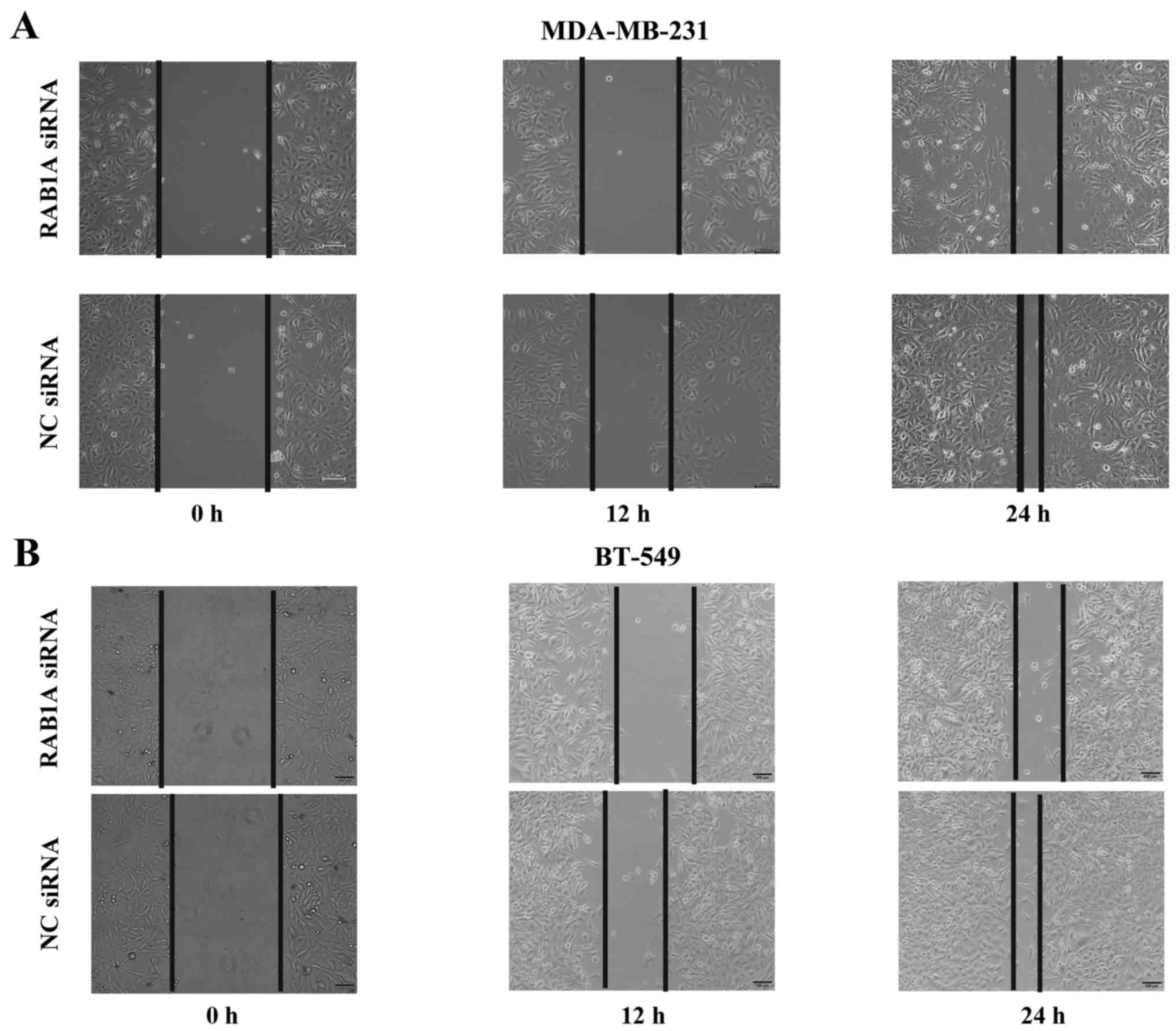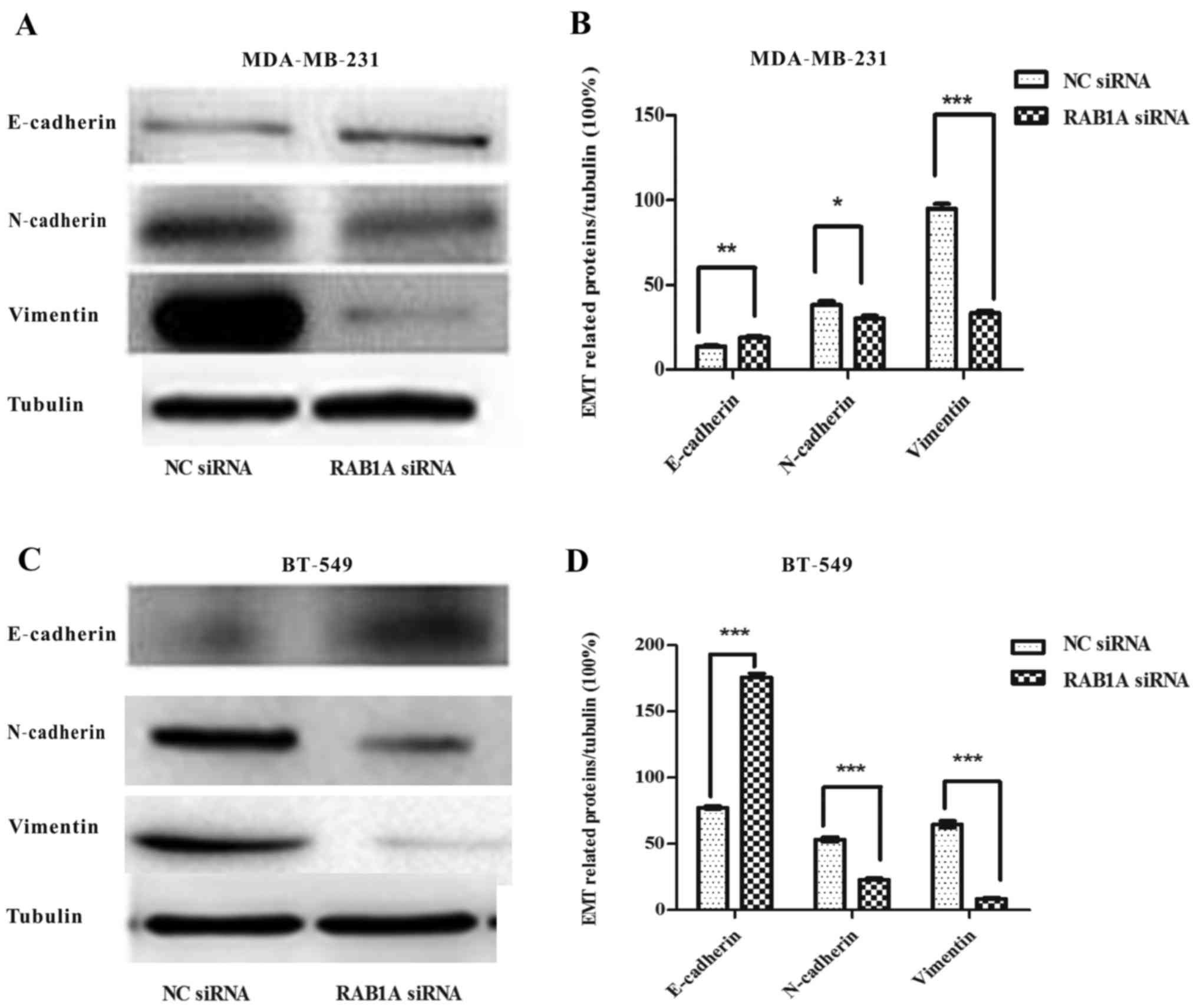Inhibition of RAB1A suppresses epithelial-mesenchymal transition and proliferation of triple-negative breast cancer cells
- Authors:
- Published online on: January 25, 2017 https://doi.org/10.3892/or.2017.5404
- Pages: 1619-1626
Abstract
Introduction
According to the investigation conducted in 2015, approximately 429,000 new cancers cases and 281,4000 cancer deaths would occur in China (1). Breast cancer ranks as the first leading cause of cancer-related death among women in less developed countries (2,3). For most breast cancer patients, surgical removal of the tumor is the first step of treatment, adjuvant therapies are recommended to follow, including systemic treatment with chemotherapy, endocrine therapy, targeted therapy and postoperative radiation therapy. Substantial advances have been made in the prognosis and treatment of breast cancers. However, the treatment progress and prevention effects were minimal. The need towards deeper understanding the pathogenesis of breast cancer is highlighted and will advance the development of novel strategies for effective control of this disease.
Member of Rab family (4), RAB1A is anchored on the membranes of endoplasmic reticulum (ER) and Golgi by prenylation and functions as controller of vesicle trafficking from ER to Golgi apparatus (5,6). The aberrant expression of RAB1A induces many diseases, such as Parkinson's disease (7), aspirin-exacerbated respiratory disease (8), cardiomyopathy (9) and cancer (10,11). mTORC1 as a complicated pathway is demonstrated to play various effects on cell survival, cell growth, cell metabolism, cell cycle and is sensitive to rapamycin (12). Mounting studies conducted recently found RAB1A is involved in the regulation of mTORC1 signaling, in colorectal, prostate and hepatocellular cancer (13–15). In 2014, Thomas et al revealed that Rab1A is an mTORC1 activator, and can stimulate oncogenic growth via mTORC1 pathway with the presence of amino acid (AA) in colorectal cancer (13). Gulhati et al reported a study on the effect of mTORC1 in regulating epithelial-mesenchymal transition (EMT) (16).
To our knowledge, characterization of RAB1A is less well developed. Thus, one goal of this study was to determine the function of RAB1A in breast cancer and its relationship with mTOR pathway. Our results may have an effect on the treatment and prognosis of breast cancer.
Materials and methods
Cell culture
The breast cancer cell lines MDA-MB-231 and BT-549 were purchased from the Cell Bank of the Chinese Academy of Sciences (Shanghai, China). MDA-MB-231 cells were cultured in Dulbecco's modified Eagle's medium (DMEM) supplemented with 10% fetal bovine serum (FBS) (Gibco, Carlsbad, CA, USA), penicillin (100 U/ml) and streptomycin (100 µg/ml) (Enpromise, Hangzhou, China). BT-549 cells were grown in RPMI-1640 medium supplemented with 10% FBS (Gibco), penicillin (100 U/ml) and streptomycin (100 µg/ml) (both from Enpromise). The cells were incubated at 37°C in a humidified atmosphere containing 5% CO2.
RAB1A small interfering RNA (siRNA) and negative control siRNA (NC siRNA) oligonucleotides were synthesized by GenePharma (Shanghai, China). The sequence of RAB1A siRNAs was sense, 5′-CAGCAUGAAUCCCGAAUAUTT-3′ and antisense, 5′-AUAUUCGGGAUUCAUGCUGTT-3′; the sequence of NC siRNA was sense, 5′-UUCUCCGAACGUGUCACGUTT-3′ and antisense, 5′-ACGUGACACGUUCGGAGAATT-3′.
Cell transfection
For transfection, MDA-MB-231 and BT-549 cells were seeded into 6-well plates with a starting cell number of 12×104 and cultured with serum and antibiotic free DMEM or RPMI-1640 medium, respectively. Cells were transfected using Lipofectamine 2000 transfection reagent (Invitrogen Life Technologies, Carlsbad, CA, USA) according to the instructions provided by the manufacturer when cells density reached 50–60%. The medium was replaced by complete DMEM or RPMI-1640 medium after 6 h of incubation. The cells were used for future analysis after 48 h transfection.
RNA isolation, reverse transcription and real-time quantitative polymerase chain reaction (RT-qPCR)
TRIzol reagent (Invitrogen Life Technologies) was used to isolate total RNA according to the manufacturer's instructions after 48 h transfection. RNA was reverse-transcribed with PrimeScript RT-PCR kit (Takara Bio Inc., Tokyo, Japan), according to the manufacturer's instructions. Conditions of the reverse transcription (RT) reaction were 37°C for 15 min, then 85°C for 5 sec. The SYBR-Green PCR master mix (Takara Bio Inc.) was used for RT-qPCR, which was followed by detection with a 7900HT fast RT-PCR instrument (Applied Biosystems, Singapore). GAPDH was used as an internal standard.
RAB1A mRNA expression was assessed with the following primers: 5′-TTGCCTTCTTCTTAGGTTTGC-3′ (forward), and 5′-GCTTGATTGTTTTCCCGTCT-3′ (reverse). RT-qPCR parameters for quantification were as follows: 2 min at 95°C, followed by 40 cycles of 15 sec at 95°C and 30 sec at 60°C. The relative expression was calculated using the relative quantification equation (RQ) = 2−ΔΔCt. Each sample was performed in triplicate.
Cell proliferation assay
Following 24 h transfection, the cells were seeded at 2×103 cells/well in 96-well plates. Cell growth was monitored every day for a period of 5 days. Then 20 µl of 3-(4,5-dimethylthiazol-2-yl)-2,5-diphenyltetrazolium bromide (MTT; Sigma-Aldrich, St. Louis, MO, USA) solution was added in each well and further incubated for 4 h. Then 150 µl dimethyl sulfoxide (DMSO; Sigma-Aldrich) was added in each well and shaken for 10 min gently to dissolve the MTT formazan crystals after removing the supernatant. Absorbance was recorded at 490 nm with a microplate reader (BioTek Instruments, Inc., Winooski, VT, USA).
Plate colony formation assay
MDA-MB-231 and BT-549 cells were seeded in a 6-well plate at 500 cells/well after 24 h of transfection, incubated for 1 week at 37°C in humidified 5% CO2 conditions. Cells were washed with PBS to remove the debris and fixed by 95% ethanol for 10 min, dried and stained with 0.1% crystal violet solution for 20 min. The number of colonies with diameters of more than 1.5 mm was counted after washing with tap water 3 times.
Cell invasion assay
Transwell chambers (Corning Inc., Lowell, MA, USA) with a pore size of 8 µm were used for invasion assay and were pre-coated with Matrigel. Cells were harvested after transfected by RAB1A siRNA or NC siRNA and resuspended with DMEM or RPMI-1640 medium without FBS. Medium (200 µl) containing 5×104 cells were added into the upper chamber with 0.1% BSA solution and added to the 24-well plate. Complete DMEM or RPMI-1640 medium was added into the bottom chamber, serving as a chemoattractant. After 16 h incubation at 37°C in 5% CO2, cells on the upper surface were carefully removed with a cotton swab. Cells penetrated to the lower surface of the membrane were fixed with 10% formalin, stained with crystal violet and counted under a microscope. Results from 1 of 3 representative experiments are shown.
Wound healing assay
To evaluate the cell mobility, wound healing assay was conducted. MDA-MB-231 and BT-549 cells were transfect. Six-well plates were used with 15×104 cells/well. The plates were washed 3 times with PBS, when the confluence of cells reached ~90%, a scratch was made using a sterile pipette tip. The process of wound healing was observed at 0, 12, 24 and 48 h after incubating at 37°C in 5% CO2. Representative migration images are presented. Each treatment was performed in triplicate.
Protein extraction and western blotting
Total cell protein content was extracted after 48–72 h transfection by using radio immunoprecipitation assay (RIPA) lysis buffer (80 µl/well; Beyotime Institute of Biotechnology, Jiangsu, China). The supernatants were collected and centrifuged at 4°C, then protein concentrations were qualified by BCA protein assay kit (Beyotime Institute of Biotechnology). Subsequently, protein samples were denatured with 6X sodium dodecyl sulfate (SDS) loading buffer at 95°C for 5 min. Protein lysates were resolved by 10 or 12% SDS-polyacrylamide gel electrophoresis (SDS-PAGE), then transferred onto a 0.45 µm nitrocellulose membrane (both from Beyotime Institute of Biotechnology). Later, the membranes were blocked with 5% skim milk for 1 h and then incubated overnight at 4°C with primary polyclonal or monoclonal antibodies as follows: anti-RAB1A (rabbit, 1:500; Proteintech, Chicago, IL, USA), anti-β-actin (mouse, 1:1,000), anti-E-cadherin (mouse, 1:750), anti-N-cadherin (mouse, 1:750), anti-vimentin (mouse, 1:750), anti-ERK (mouse, 1:1,000), anti-phospho-ERK (mouse, 1:1,000), anti-AKT (mouse, 1:1,000), anti-phospho-AKT (mouse, 1:1,000) and anti-pS6K (mouse, 1:1,000) (all from Cell Signaling Technology, Inc., Danvers, MA, USA), anti-phospho-pS6K (Ser-418, mouse, 1:1,000; Ruiying Biological, Jiangsu, China). Next, the membranes were washed three times with PBST for 10 min each time, and incubated with anti-mouse or anti-rabbit secondary antibody (1:1,000; Epitomics, Burlingame, CA, USA) for 1 h at room temperature. Finally, after 3 times wash with PBST, the target proteins were detected with an Odyssey Scanning system (LI-COR Biosciences, Lincoln, NE, USA). The expression levels of the target protein were normalized to those of β-actin or tubulin. Each treatment was performed in triplicate.
Statistical analysis
The data were analyzed using the SPSS, version 20.0 (IBM Corp., Somers, NY, USA) or GraphPad Prism, version 6.0 (GraphPad Software, San Diego, CA, USA). The data were expressed as the mean ± standard error of the mean (SEM) for at least 3 repeated individual experiments for each group. Statistical analyses were performed using an unpaired two-tailed Student's t-test. P-values <0.05 were considered statistically significant.
Results
Expression of RAB1A is downregulated by siRAB1A in breast cancer cells
The RT-qPCR and western blotting were conducted to analyze the expression of RAB1A at the protein level and mRNA level, respectively. As shown in Fig. 1A and B, MDA-MB-231 and BT-549 cells were successfully transfected with siRAB1A, leading to the significant suppression of RAB1A mRNA expression. Furthermore, the expression of target proteins were effectively inhibited in siRNA transfected breast cancer cells compared with NC cells (Fig. 2; P<0.001). According to the experiments above, the suppression effects of siRAB1A on RAB1A expression were verified.
RAB1A siRNA inhibits the expression of mTORC1 effector p-P70S6K
To verify the relationship between RAB1A and S6K. RAB1A expression was suppressed by RAB1A siRNA and the expression of S6K was detected by western blotting. According to Fig. 3A and B, following the downregulation of RAB1A in protein level, protein expression of p-P70S6K was decreased in breast cancer cells, while the expression of p-ERK or p-AKT had no change. All the results above indicate the vital role of RAB1A in regulation of activation of S6K. The integrated density values of bands were as shown in Fig. 3C and D (P<0.05, P<0.01).
Proliferation ability of breast cancer cells is suppressed by the RAB1A siRNA
To investigate the impact of siRAB1A on the proliferation ability of breast cancer cells, both MDA-MB-231 and BT-549 cells transfected with RAB1A siRNA or non-specific NC were used in the MTT assay. Transfections were performed as described above. Absorbance of the two groups was recorded at 24, 48, 72, 96 and 120 h. Briefly, inhibition rate was calculated as: inhibition rate (%) = (OD value of the control group - OD value of experimental group)/OD value of the control group × 100%. A great suppression of cell viability at 120 h in RAB1A siRNA transfected cells was detected compared with the control group, both in MDA-MB-231 cells (inhibition rate = 14.78±6.54%, Fig. 4A; P<0.01) and BT-549 cells (inhibition rate = 25.06±9.20%, Fig. 4B; P<0.001). These results indicated RAB1A depletion suppressed cellular proliferation.
Colony formation was inhibited by the RAB1A siRNA in breast cancer cells
As shown in Fig. 5A and B, RAB1A siRNA transfected cells exhibited fewer colonies than NC transfected cells in colony formation assays. The colony formation rate in RAB1A siRNA-transfected MDA-MB-231 was significantly decreased compared with the NC transfected cells (Fig. 5C; P<0.01). The same tendency was shown in BT-549 cells (Fig. 5D; P<0.01). Taken together, these data indicated that depletion of RAB1A inhibited clonogenesis of breast cancer cells.
RAB1A siRNA reduces cell invasion and metastasis in vitro
To evaluate the effect of RAB1A siRNA on breast cancer metastasis, two aggressive breast cancer cell lines MDA-MB-231 and BT-549 were transiently transfected with RAB1A siRNA or NC control. The invasion and migration of cells were measured by Transwell assays and wound healing assays, respectively. All the results revealed that the number of MDA-MB-231 or BT-549 cells penetrated to the lower membrane was significantly decreased at 16 h after RAB1A siRNA transfection compared to the control group (Fig. 6). Notably, as shown in Fig. 7, RAB1A siRNA but not NC siRNA markedly decrease the migratory property of these breast cancer cells.
RAB1A depletion suppresses EMT in breast cancer cells
Next, we explored the role of RAB1A siRNA in breast cancer EMT. Western blotting were carried out. Fig. 8A and C shows, the expression of E-cadherin protein, an epithelial cell marker, was increased in RAB1A siRNA transfected MDA-MB-231 and BT-549 cells while the mesenchymal markers N-cadherin and vimentin were decreased. The integrated density values of bands were measured and shown (Fig. 8B and D; P<0.05, P<0.01, P<0.001). Taken together, these results indicated that RAB1A depletion in breast cancer cells may be responsible for the EMT suppression and cell migration suppression.
Discussion
As the leading cause of cancer-related death among women worldwide, breast cancer have a severe influence on the living standard of the patients. During the investigation of the potential role in breast cancer, RAB1A siRNA was transfected in the MDA-MB-231 and BT-549 cells. Cell invasion and proliferation abilities were significantly abolished by depletion of RAB1A according to the Transwell and MTT assay, respectively. Moreover, our data showed that the downregulated expression of RAB1A increased the epithelial cell marker E-cadherin in breast cancer cells, while the mesenchymal cell markers, N-cadherin and vimentin, were decreased (17). The loss of E-cadherin mediated adherens junction was the first step in EMT and plays a vital role in cells invasiveness and distance metastasis (18). All the results indicate EMT suppression mediated by exogenous silencing of RAB1A contributing to the inhibition of breast cancer metastasis.
mTOR pathway as an important regulator in malignant tumor process consists of two complexes, mTORC1 and mTORC2. As an important effector of mTORC1, p-P70S6K plays a vital role in regulating cell growth, invasion, and lymph node metastasis in colorectal cancer (19). In this experiment, downregulated expression of RAB1A by transfection with RAB1A siRNA suppressed the expression of p-P70S6K, rather than the p-AKT and p-ERK, which revealed a close connection between RAB1A and p-P70S6K and the reasons for the suppression of proliferation and metastasis by exogenous silencing of RAB1A gene in breast cancer.
Several groups have already investigated the function of RAB1A in colorectal cancer and what we found in this study was in accordance with previous reports that RAB1A depletion was involved in the suppression of mTORC1 pathway and it acts in oncogenesis of breast cancer proliferation, growth and metastasis. Our results may help the finding of new strategies for the treatment of breast cancer.
A number of limitations should be noted in this study. Clinical specimens were not used. The relationship between RAB1A expression and patient survival was not identified. Therefore, further studies are needed.
Acknowledgements
This study was supported by the National Natural Sciences Foundation of China for the project 81272240.
Glossary
Abbreviations
Abbreviations:
|
EMT |
epithelial-mesenchymal transition |
|
RT-qPCR |
real-time quantitative polymerase chain reaction |
|
DMSO |
dimethyl sulfoxide |
|
MTT |
3-(4,5-dimethylthiazoyl-2-yl)-2,5-diphenyl tetrazolium bromide |
References
|
Chen W, Zheng R, Baade PD, Zhang S, Zeng H, Bray F, Jemal A, Yu XQ and He J: Cancer statistics in China, 2015. CA Cancer J Clin. 66:115–132. 2016. View Article : Google Scholar : PubMed/NCBI | |
|
Jemal A, Bray F, Center MM, Ferlay J, Ward E and Forman D: Global cancer statistics. CA Cancer J Clin. 61:69–90. 2011. View Article : Google Scholar : PubMed/NCBI | |
|
Torre LA, Bray F, Siegel RL, Ferlay J, Lortet-Tieulent J and Jemal A: Global cancer statistics, 2012. CA Cancer J Clin. 65:87–108. 2015. View Article : Google Scholar : PubMed/NCBI | |
|
Schöppner P, Csaba G, Braun T, Daake M, Richter B, Lange OF, Zacharias M, Zimmer R and Haslbeck M: Regulatory implications of non-trivial splicing: isoform 3 of Rab1A shows enhanced basal activity and is not controlled by accessory proteins. J Mol Biol. 428:1544–1557. 2016. View Article : Google Scholar : PubMed/NCBI | |
|
Allan BB, Moyer BD and Balch WE: Rab1 recruitment of p115 into a cis-SNARE complex: programming budding COPII vesicles for fusion. Science. 289:444–448. 2000. View Article : Google Scholar : PubMed/NCBI | |
|
Satoh A, Wang Y, Malsam J, Beard MB and Warren G: Golgin-84 is a rab1 binding partner involved in Golgi structure. Traffic. 4:153–161. 2003. View Article : Google Scholar : PubMed/NCBI | |
|
Coune PG, Bensadoun JC, Aebischer P and Schneider BL: Rab1A over-expression prevents Golgi apparatus fragmentation and partially corrects motor deficits in an alpha-synuclein based rat model of Parkinson's disease. J Parkinsons Dis. 1:373–387. 2011.PubMed/NCBI | |
|
Park JS, Heo JS, Chang HS, Choi IS, Kim MK, Lee JU, Park BL, Shin HD and Park CS: Association analysis of member RAS oncogene family gene polymorphisms with aspirin intolerance in asthmatic patients. DNA Cell Biol. 33:155–161. 2014. View Article : Google Scholar : PubMed/NCBI | |
|
Wu G, Yussman MG, Barrett TJ, Hahn HS, Osinska H, Hilliard GM, Wang X, Toyokawa T, Yatani A, Lynch RA, et al: Increased myocardial Rab GTPase expression: a consequence and cause of cardiomyopathy. Circ Res. 89:1130–1137. 2001. View Article : Google Scholar : PubMed/NCBI | |
|
Shimada K, Uzawa K, Kato M, Endo Y, Shiiba M, Bukawa H, Yokoe H, Seki N and Tanzawa H: Aberrant expression of RAB1A in human tongue cancer. Br J Cancer. 92:1915–1921. 2005. View Article : Google Scholar : PubMed/NCBI | |
|
Yang Y, Hou N, Wang X, Wang L, Chang S, He K, Zhao Z, Zhao X, Song T and Huang C: miR-15b-5p induces endoplasmic reticulum stress and apoptosis in human hepatocellular carcinoma, both in vitro and in vivo, by suppressing Rab1A. Oncotarget. 6:16227–16238. 2015. View Article : Google Scholar : PubMed/NCBI | |
|
Wang X, Chu Y, Wang W and Yuan W: mTORC signaling in hematopoiesis. Int J Hematol. 103:510–518. 2016. View Article : Google Scholar : PubMed/NCBI | |
|
Thomas JD, Zhang YJ, Wei YH, Cho JH, Morris LE, Wang HY and Zheng XF: Rab1A is an mTORC1 activator and a colorectal oncogene. Cancer Cell. 26:754–769. 2014. View Article : Google Scholar : PubMed/NCBI | |
|
Sun T, Wang X, He HH, Sweeney CJ, Liu SX, Brown M, Balk S, Lee GS and Kantoff PW: miR-221 promotes the development of androgen independence in prostate cancer cells via downregulation of HECTD2 and RAB1A. Oncogene. 33:2790–2800. 2014. View Article : Google Scholar : PubMed/NCBI | |
|
Xu BH, Li XX, Yang Y, Zhang MY, Rao HL, Wang HY and Zheng XF: Aberrant amino acid signaling promotes growth and metastasis of hepatocellular carcinomas through Rab1A-dependent activation of mTORC1 by Rab1A. Oncotarget. 6:20813–20828. 2015. View Article : Google Scholar : PubMed/NCBI | |
|
Gulhati P, Bowen KA, Liu J, Stevens PD, Rychahou PG, Chen M, Lee EY, Weiss HL, O'Connor KL, Gao T, et al: mTORC1 and mTORC2 regulate EMT, motility, and metastasis of colorectal cancer via RhoA and Rac1 signaling pathways. Cancer Res. 71:3246–3256. 2011. View Article : Google Scholar : PubMed/NCBI | |
|
Makki J, Myint O, Wynn AA, Samsudin AT and John DV: Expression distribution of cancer stem cells, epithelial to mesenchymal transition, and telomerase activity in breast cancer and their association with clinicopathologic characteristics. Clin Med Insights Pathol. 8:1–16. 2015. View Article : Google Scholar : PubMed/NCBI | |
|
Zheng K, Zhou X, Yu J, Li Q, Wang H, Li M, Shao Z, Zhang F, Luo Y, Shen Z, et al: Epigenetic silencing of miR-490-3p promotes development of an aggressive colorectal cancer phenotype through activation of the Wnt/β-catenin signaling pathway. Cancer Lett. 376:178–187. 2016. View Article : Google Scholar : PubMed/NCBI | |
|
Lu Q, Wang J, Yu G, Guo T, Hu C and Ren P: Expression and clinical significance of mammalian target of rapamycin/P70 ribosomal protein S6 kinase signaling pathway in human colorectal carcinoma tissue. Oncol Lett. 10:277–282. 2015.PubMed/NCBI |



